Posted by Elena del Valle on July 8, 2008
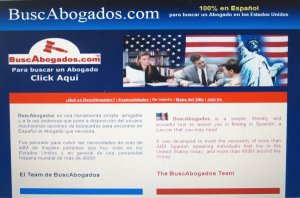
BuscAbogados.com – click on image to enlarge
Photos: BuscAbogados.com
In May 2008, BGB Holding Group Corp launched BuscAbogados.com (Spanish look for a lawyer), a new website in Spanish for adults in the United States, Latin America and Spain, who have access to the Internet and are seeking the services of a United States attorney. It took two years of development work to design the website as a bilingual search engine able to recognize key search words in Spanish and English.
The newly launched website lists 7,000 Florida attorneys. BuscAbogados relies on seven employees in the United States and 50 in Argentina. In addition to English and Spanish press releases, company representatives are promoting the website with printed promotional materials distributed in markets with large Hispanic populations as well as advertising in Miami area Hispanic publications.
“How to Use Your Energy to Attract Clients and Customers” audio recording

Presenter Heather Dominick, owner, EnergyRich Coaching, Inc.
A 106-minute audio recording including a presentation by Heather and the complete interview with Heather where she discusses:
- Heather’s step by step system for women entrepreneurs
- Her coaching philosophy that an individual needs to be business at a holistic level
- Core beliefs about creating magnificent marketing for your business
- How Heather transitioned from a high school drama teacher to a coach
- The three Os that characterized her life at the time
- Heather’s first steps to changing her life
Click here for information on How to Use Your Energy to Attract Clients and Customers
Ready to buy? Select a format to add to your shopping cart:
Downloadable “ How to Use Your Energy to Attract Clients and Customers ” MP3 $119.95
Audio CD’s “How to Use Your Energy to Attract Clients and Customers ” $139.95
BuscAbogados.com marketers have concentrated their efforts on website optimization in the hope of positioning the portal among the most important Internet search engines, as well as regionally-focused search engines in Latin America where they believe their services will also be of interest.

Luis Bregni, president, BuscAbogados.com
“We’re excited to be able to help the growing Hispanic market find the lawyers they need, and feel the Internet is our best medium for doing so,” said Luis Bregni, president and owner of BuscAbogados.com. “The Internet is actually more than perfect; it’s where millions of people first turn to for finding restaurants, jobs and even medical advice. So, why not give lawyers their own spot on the World Wide Web in this niche market and, at the same time, open up an easy avenue for the online Hispanic user to search for a lawyer.”
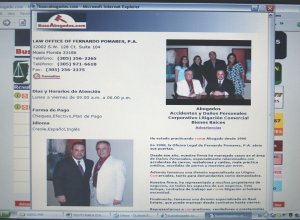
Click on image to enlarge
The website allows visitors to browse free and invites law firms to place ads for a monthly fee. For example, the $39 Standard Package offers law firms a listing with a photo and a 500-word description. There are also Professional, Premium and Platinum packages.
Bregni, originally from Argentina, has 25 years of experience working with Argentine banks and other financial institutions. He holds a degree in Economic Sciences from the University of Buenos Aires and is director of Grupo NOP in Argentina.
Two other executives, Erwin Diaz-Solis and Julio Stieffel, are listed on the BuscAbogado pages in addition to Bregni. Diaz-Solis specializes in immigration law and is a graduate of Nova Southeastern University in Fort Lauderdale, Florida. Stieffel, a graduate of the University of Miami, founded Americas Rep International, an international consulting firm specializing in the Latin American market. BuscAbogados.com, a Miami Springs company, is managed by BGB Holding Group Corp., Grupo NOP Argentina’s North America division.
Hispanic Marketing and Public Relations Understanding and Targeting America’s Largest Minority book

“A must resource for practitioners/professionals expecting to reach US Hispanics; also valuable for college programs in marketing, public relations and communications. Highly recommended.”
Choice magazine
Click here for information on the Hispanic Marketing & Public Relations books
Posted by Elena del Valle on June 26, 2008

Downtown Orlando
Photo, charts: Orlando/Orange County Convention & Visitors Bureau, Metro Orlando Economic Development Commission
Partly because of Miami’s world renown as a Latino hub, and partly due to Orlando’s image as theme park destination, that central Florida city is often overlooked by marketers targeting Latino consumers. About 500,000 Latinos live in the Orlando, Daytona Beach and Melbourne area, representing about 21 percent of the market, according to the Metro Orlando Economic Development Commission. Some are starting to take notice of this area’s diverse population.
As traditional media targeting mainstream audiences continue to slash staff in a seemingly never ending quest to survive, Orlando media, realizing almost a quarter of their audience is Hispanic, are beginning to pay attention to the growing demographic, reflecting a national trend.
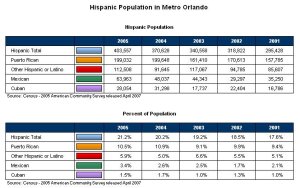
Hispanic Population in Metro Orlando – click on image to enlarge
From a media perspective, the metropolitan area ranks 19 in the Neilsen Media Research Designated Television Market Area (TV DMA) and 34 in the Radio Metro lists. In 2007, Entravision Communications bought an FM station, WNUE, marking the eleventh urban area where the company owns radio and television stations. Santa Monica based Entravision owns WVEN, the local Univision affiliate and operates WOTF, the Telefutra station, providing Spanish speakers in the area more than one viewing option.
WNUE’s popularity is starting to show. Last fall, the station tied with WRUM-FM, the Clear Channel station, for top Spanish station. It’s no wonder with half of the state’s 750,000 Puerto Ricans living near Disney, according to an online source. After Puerto Ricans, Latinos of Mexican, Colombian and Dominican origin are the most common.
Target Latinos effectively by anticipating changes in the market with
“Hispanic Projections with 2007-08 update” audio recording

Presenter Roger Selbert, Ph.D.
Find out
- About Latino buying power growth in the future
- How Latino market growth compares with other markets in the U.S.
- What drives the rise of Latino economic clout
- Who should target the Latino market
- What is the size of the Hispanic affluent market
- If the luxury Latino market is growing
Stay ahead of your competition with “Hispanic Projections”
According to a 2007 report by Fishkind & Associates, Inc., Central Florida’s Latino population is growing at a faster pace than other segments of the population. The researchers project the Hispanic community will grow at a rate 2 to 4 percent higher than non-Hispanics by the end of the decade.
The researchers also believe that 41 percent of Osceola County’s population will have Hispanic roots by 2009. At the same time, over the past seven years personal income for the area’s Hispanics rose 64 percent and is projected to increase an additional 12 percent by 2010 to reach $10.5 billion or more.
Fishkind & Associates is an Orlando economic consulting firm that conducts market and demographic research. The 2007 findings were part of the company’s second dedicated Hispanic market study. A non profit, private/public partnership, the Economic Development Commission serves Orange, Seminole, Lake and Osceola counties and the City of Orlando. The organization staff try to attract new business investment and work with local companies to facilitate expansion plans.
Find out which Latino markets are booming with
“The Next Step: Secondary Latino Markets” audio recording

Presenter Dora O. Tovar, MPA
Click here for information on Secondary Latino Markets
Posted by Elena del Valle on June 25, 2008
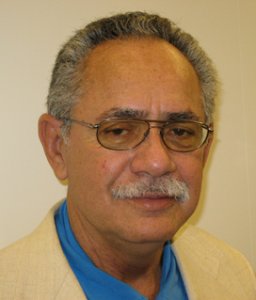
Rodolfo de la Garza, project director
Photo: Rodolfo de la Garza
According to a recently released study,”African American and Latino Enrollment Trends among Medicine, Law, Business, and Public Affairs Graduate Programs,” funded by the Ford Foundation and conducted by researchers from the Tomás Rivera Policy Institute (TRPI), few Latino and African American students are enrolling in medicine, law, business, and public affairs graduate programs. This is due in part to a low number of high school graduates among these ethnic groups and the bachelor’s degree entry requirement of the programs. Affirmative action and law suits related to affirmative action have also been contributors, according to the report.
The report was prepared by Rodolfo de la Garza, project director, and Sepehr Hejazi Moghadam, research associate, of the Tomas Rivera Policy Institute office at Columbia University. The researchers selected disciplines “where policy makers go and come from” and those they believe most influence the nation. They approached the top 10 public and private schools and programs in each category to request interviews and information. The study took place over an 18 month period beginning in 2006.
“Many of the universities wouldn’t respond or said they don’t provide that kind of study,” said de la Garza about how the universities reacted to project. “Ford gave a rather handsome grant of more than $15,000.”
Target Latinos effectively by anticipating changes in the market with
“Hispanic Projections with 2007-08 update” audio recording

Presenter Roger Selbert, Ph.D.
Find out
- About Latino buying power growth in the future
- How Latino market growth compares with other markets in the U.S.
- What drives the rise of Latino economic clout
- Who should target the Latino market
- What is the size of the Hispanic affluent market
- If the luxury Latino market is growing
Stay ahead of your competion with “Hispanic Projections”
The researchers believe the elimination of affirmative action has decreased the number of underrepresented students enrolling in medical schools. Based on the data they were able to gather, African American applicants who applied to the top 10 public and private medical schools declined by 25 percent from 5,379 in 1995 to 4,033 in 2001. Latino applicants to the same schools decreased 38.6 percent, from 2,769 in 1995 to 1,700 in 2001. Together, African American and Latino enrollment in the nation’s top 10 public and private medical schools declined by 11.2 percent and 27 percent respectively.
As an example of the drop in law school registrations because of California’s anti-affirmative action movement the report points to California law schools. From fall 1995 to fall 2006, the number of admitted African American and Latino students in University of California’s three law schools declined 28 percent.
While there was an increase in undergraduate business degrees awarded to African American and Latino students over the past nine years, these degrees rose from 9 percent of total degrees in the country between 1995 and 1996, to 15 percent between 2003 and 2004; the researchers point out that the growth in enrollment does not match the growth of the African American and Latino markets, currently 25 percent. There are more African Americans and Latinos graduating with MBA degrees than other master’s degrees and this number once again do not reflect the growth of the African American and Latino populations in the United States.
On the good news front, more diverse students are graduating with public affairs master’s degrees which train students for careers in government, business, media, nonprofit organizations, non governmental and international organizations. Master’s degrees in traditionally underrepresented groups have increased from 18 percent in 1996 to 25 percent in 2004. Once again the increase is inconsistent with the growth of the African American and Latino populations nationwide.
Founded in 1985, the Tomás Rivera Policy Institute (TRPI) advances informed policy on key issues affecting Latino communities through objective and timely research contributing to the betterment of the nation. TRPI is an affiliated research unit of the University of Southern California School of Policy, Planning, and Development and is associated with the Institute for Social and Economic Research and Policy at Columbia University.
Find out which Latino markets are booming with
“The Next Step: Secondary Latino Markets” audio recording

Presenter Dora O. Tovar, MPA
Click here for information on Secondary Latino Markets
Posted by Elena del Valle on June 24, 2008

Casio Spanish language ad
Photos: Revolucion NYC
Casio executives recently decided to introduce one of their products to Spanish speaking Latinos in the United States for the first time. Revolucion NYC won the account with an ad campaign touting the benefits of the EXILIM EX-S10, a thin digital camera, and recruiting television celebrity Lili Estefan, known by her nickname La Flaca, as spokesperson.
“Why don’t we have La Flaca selling another flaca,” said Amy Gomez, managing partner and director, Account Services at Revolucion NYC about the brainstorming session where the campaign was born. “Two weeks after that thought we were shooting in Miami.”

Amy Gomez, managing partner and director, Account Services at Revolucion NYC
To begin, Casio staff selected two markets, Houston and Los Angeles, to launch the campaign which began running May 6 and will conclude in early July 2008. The two-pronged campaign is appearing on 30-sheet billboards in Houston and 8-sheet billboards in Los Angeles and online.
Spanish speaking residents of Los Angeles and Houston who see the banner ads are driven to a microsite created by the agency. Consumers are invited to purchase the camera at retail stores, especially through Best Buy and La Curacao, two program partners.

Casio Spanish language ad – click on image to enlarge
According to Gomez, after trying out the camera for the first few days, Estefan was so enthusiastic she requested 15 more cameras to give as gifts to her friends, and volunteered eagerly to assist in the public relations efforts for the camera.
Make your ads resonate with Hispanics
Listen to C&R’s Research Director Liria Barbosa in
“Hispanics’ Perspective on Advertising” audio recording

Liria Barbosa gives a presentation and participates in an extended Q&A discussion about
• Type of ads Latinos prefer
• Latino top media choices
• Percent of Latinos who tried products because of ads
• Percent of Latinos who purchased products because of ads
• What makes an ad “Hispanic”
• If ad language is important for bicultural Latinos
• What to keep in mind when targeting bicultural Latinos with ads
Click here for information on Hispanic Perspectives on Advertising
The agency produced seven different ads, each one boasting about a different feature, according to Roberto Alcazar, executive creative officer at Revolucion NYC. It took three creative team members two months from beginning to end to create and develop the ads. The team members were Alcazar, Josefina Fuster, and Alberto Rodriguez. The photos were taken at Kikor Studio in Miami.
“Revolucion presented us with an integrated, turnkey approach to bring this unique product to the market,” said Sue VanderSchans, director of Strategic Communications and Marketing, Casio America.
Plans are to add Miami and one additional market and restart the campaign in October 2008 in time for the holiday season. The camera sells for $249.99 and is 3.71 inches wide by 2.15 inches tall and .59 inches thick. At its thinnest it is 0.54 thick, giving rise, according to Gomez, to the camera’s Spanish language nickname of la flaca. The weight, excluding battery and accessories, is 3.99 ounces.
Revolucion Hispanic Communications is a seven year old Hispanic-owned brand-communications agency based in New York City. The Japan based Casio Computer Company Ltd. was founded in 1957 and has 13,202 employees.
“Moving Beyond Traditional Media Measurement: measuring conversations and social media” audio recording

Presenter Katie Delahaye Paine, founder, KDPaine & Partners
Find out about
- Issues affecting online public relationships today
- Testing relationships as part of a survey
- Measuring ethnic group relationships
- Measuring foreign language communications in a similar ways to English
- Biggest challenges measuring conversations and social media
- Measuring online relationships with little or no money
Click here for information on “Moving Beyond Traditional Media Measurement”
Posted by Elena del Valle on June 19, 2008

An artist rendering of Tacos & Tequila – click on image to enlarge
Photos: Luxor Hotel and Casino
The Luxor Hotel and Casino in Las Vegas, Nevada is planning to open a new 8,000 square foot restaurant with a modern look and Mexican style menu this summer. Michael Frey, the driving force behind the project, recruited Chef Richard Sandoval and Designer Adam Tihany to make the project come alive. It will be the first project of his new company, Drive This Entertainment!
“This is not your grandma’s cantina; think Pink Taco meets Coyote Ugly interpreted by Quentin Tarantino,” said Frey. “I am excited to bring our version of a sexy, energy infused Mexican restaurant to life. Offering more than just a great place to grab an amazing taco or great tequila, it will be a dining experience that will tantalize the senses.”
“Best in Class Hispanic Strategies” audio recording


Presenters Carlos Santiago and Derene Allen
-
Find out what makes 25 percent of the top 500 Hispanic market advertisers out perform the remaining companies
-
Discover what questions to ask, steps to take to be a Best in Class company
Click here for more about “Best in Class Hispanic Strategies” audio recording
To bring his edgy vision to life, Frey partnered with friend Tihany and Alvarez + Brock Design, a New York-based hospitality design firm. They were inspired by what they believe are five essential elements of Mexican culture: the sombrero, the shot glass, the bullfight, skeletons and seductive women.
The target audience? Anyone who likes tacos and tequila, according to a company spokesperson. On the marketing side, plans are in place to position Tacos & Tequila, referred to as T&T in promotional materials, as the newly favored Mexican restaurant on The Strip through an aggressive public relations campaign; and “focusing on building brand awareness throughout the Las Vegas valley and feeder markets, garnering key TV and print media placements, as well as through grassroots efforts aimed at creating a buzz that drives traffic to the restaurant.”

An artist rendering of Tacos & Tequila – click on image to enlarge
On the food side of things Sandoval will be consulting chef. The menu is expected to include a juxtaposition of modern and traditional Mexican cuisine as well as an extensive list of tequilas specialty cocktails and infused tequilas. In addition to serving lunch and dinner, promoters hope T&T’s El Salon will become a popular nightlife spot. It will be open from11 a.m. to 11 p.m. and offer late-night dining from the taco bar until 3 a.m.
The designers plan a massive brushed aluminum ceiling to pay tribute to the sombrero. There will also be two 20-foot laser cutouts of dancing skeletons and the cover will be lined with lights that shoot down to the ground reflecting the skeleton images on the concrete floor.
Chair coverings and decorative lighting will be in hues of yellow, red, green, orange and blue. The bar will resemble a bull-fighting arena. Seated on stadium-style shelves, the liquor bottles will be arranged like spectators overlooking a fierce bullfight, painted as a large mural below while rock ‘n‘ roll music plays in the background.
Plans call for a freestanding frozen daiquiri bar selling drinks to guests on the go and a clothing and souvenir shop. The boutique will specialize in men’s and women’s shirts, women’s logo-embroidered jean shorts and capris with the signature “T” on the back pocket.
“Segmentation by Level of Acculturation” audio recording

Presenter Miguel Gomez Winebrenner
Discusses
- Assimilation versus acculturation
- Factors that affect Latino acculturation
- How to know if someone is acculturated
- Number of years necessary for acculturation
- Effects of immigration debate on acculturation
- Three main ways of segmenting Latinos
Click here for details about “Segmentation by Level of Acculturation”
Posted by Elena del Valle on June 18, 2008

Jena Atchison, manager Segment Marketing, Southwest Airlines
Photo, video: Southwest Airlines
Southwest Airlines marketing executives hope to win new customers from among Spanish speaking Latinos in the United States with Relax!, a newly launched Spanish language television campaign scheduled to air from early June until the fall season 2008. In the past10 ten years, the company has released eight Spanish language ad campaigns with the help of its agency. Scroll down to watch two of the Southwest Airlines Relax! ads in Spanish.
The Relax! commercials, designed to promote hassle free travel, will run on Univision, Telemundo, and Azteca networks. The title Relax! was designed to show prospective customers that Southwest understands the difficulties travelers may have before a vacation and how the airline can provide “a better environment so that customers can start a great relaxing journey.” The campaign was created by Dieste, Harmel and Partners.
The Relax! ads were shot in various locations over two days in Mexico City. Although airline representatives do not have data on the number of Hispanic customers they serve, they are evaluating metrics to allow them to determine those numbers in the future. In 2007, Southwest spent almost 18 million on Spanish language television ads, slightly more than the previous year according to Nielsen Monitor-Plus.
“Best in Class Hispanic Strategies” audio recording


Presenters Carlos Santiago and Derene Allen
-
Find out what makes 25 percent of the top 500 Hispanic market advertisers out perform the remaining companies
-
Discover what questions to ask, steps to take to be a Best in Class company
Click here for more about “Best in Class Hispanic Strategies” audio recording
The company has launched Spanish language campaigns in the past to promote low fares and affordability. Marketers hope the new campaign will position Southwest among Hispanics as an approachable airline that understands and respects them. The company wants to let Hispanic customers know that employees do “whatever it takes to provide them with friendly service and a pleasant experience.”
“At Southwest Airlines we believe in giving our customers the freedom to fly, access to low fares, and excellent service. Our campaign demonstrates the accessibility of our airline with a clear message of hassle-free travel,” said Jena Atchison, manager Segment Marketing for Southwest Airlines.
Dallas based Southwest Airlines serves 64 cities in 32 states. Southwest operates more than 3,400 flights a day and has more than 33,000 employees system wide. Southwest boasts of premium all leather seats and extra legroom with a young, all-Boeing 737 fleet. According to promotional materials, Southwest is fee averse; the airline has no first or second checked bag fees, no change fees, no fuel surcharges, no snacks fees, no aisle or window seat fees, no curbside check-in fees, and no phone reservations fees.
Hispanic Marketing and Public Relations Understanding and Targeting America’s Largest Minority book

“A must resource for practitioners/professionals expecting to reach US Hispanics; also valuable for college programs in marketing, public relations and communications. Highly recommended.”
Choice magazine
Click here for information on the Hispanic Marketing & Public Relations books
Posted by Elena del Valle on June 16, 2008

Alberto Oliva, editor-in-chief, Ser Padres
Photo: Meredith Corporation
A podcast interview with Alberto Oliva, editor-in-chief, Ser Padres is available in the Podcast Section of Hispanic Marketing & Public Relations, HispanicMPR.com. During the podcast, he discusses the magazine with Elena del Valle, host of the HispanicMPR.com podcast.
Alberto joined Meredith Corporation, the parent company of Ser Padres, in October 2001 bringing more than 30 years of experience with Hispanic media as an editor, journalist and author. Ser Padres is Meredith’s parenting magazine for Hispanics launched in the fall of 1990 and one of the largest Spanish-language consumer magazines in the United States.
Prior to joining Ser Padres, Alberto was associate editor for People en Español from 1998-2001, U.S. bureau chief for Editorial Atlantida from 1984 to 1998 where he first began his career in 1970 as a journalist. During this time he also served as a reporter and journalist for the Associated Press in New York from 1976-1978.
Make your ads resonate with Hispanics
Listen to C&R’s Research Director Liria Barbosa in
“Hispanics’ Perspective on Advertising” audio recording

Liria Barbosa gives a presentation and participates in an extended Q&A discussion about
• Type of ads Latinos prefer
• Latino top media choices
• Percent of Latinos who tried products because of ads
• Percent of Latinos who purchased products because of ads
• What makes an ad “Hispanic”
• If ad language is important for bicultural Latinos
• What to keep in mind when targeting bicultural Latinos with ads
Click here for information on Hispanic Perspectives on Advertising
Alberto authored two books, Magazines that Make History published August 2004, and In Vogue, A visual history of the most influential fashion magazine in the world published October, 2006. He has a master’s degree in Communications from the Instituto Nacional del Profesorado in Buenos Aires, Argentina.
A resident of New York City, he has been a visiting professor at the University of Salamanca in Spain from 2005 to 2008, at Stanford University in California from 2005 to 2007, and at New York University in New York in 2006. He is fluent in Spanish, French, Italian and Portuguese.
To listen to the interview, scroll down until you see “Podcast” on the right hand side, then select “HMPR Alberto Oliva” click on the play button or download it to your iPod or MP3 player to listen on the go, in your car or at home. You can also subscribe to the podcast by right clicking over the podcast box and selecting “copy shortcut” then inserting the URL address in the podcast section of your iTunes program listed under the “advanced” column. The podcast will remain listed in the June 2008 section of the podcast.
“Best in Class Hispanic Strategies” audio recording


Presenters Carlos Santiago and Derene Allen
-
Find out what makes 25 percent of the top 500 Hispanic market advertisers out perform the remaining companies
-
Discover what questions to ask, steps to take to be a Best in Class company
Click here for more about “Best in Class Hispanic Strategies” audio recording
Posted by Elena del Valle on June 12, 2008
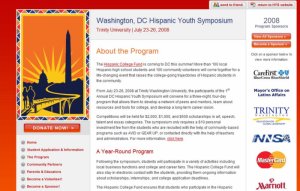
A Hispanic Youth Symposium website – click on image to enlarge
Photos: The Hispanic College Fund
Last week, the Hispanic College Fund launched seven regionally-focused websites dedicated to its annual Hispanic Youth Symposia taking place this summer. Each website is designed to provide an online forum for local communities to support their Hispanic Youth Symposium (HYS) by informing visitors about community partners and sponsors, and providing instructions on how to donate and volunteer.
Representatives of the Hispanic College Fund, established in 2004, hope to reach a national audience of 8,000 people. They are promoting the websites through a press release distribution, on the organization’s upcoming e-newsletter targeting 125,000 past scholarship applicants, and on Facebook.
In 2008, the Hispanic College Fund will offer a symposium in seven cities: Fresno, California; Phoenix, Arizona; Albuquerque, New Mexico; Washington, DC; Baltimore, Maryland; Fairfax and Richmond, Virginia. Organizers plan to expand the program to four or more cities in Southern California and other regions in 2009. Fund representatives believe that 1,400 students, participants in each of the seven 2008 Hispanic Youth Symposia across the nation, will directly benefit from the websites.
The websites provide information for students including how to apply for symposia that are still open and who to contact. There is also information on year-round programming that follows HYS, answers to frequently asked questions, an interactive national map and details about activities like workshops on business etiquette and resume writing. Visitors may also join the Hispanic College Fund’s list serve.

Lisa Sandoval, director of Communications, Hispanic College Fund
“The Hispanic College Fund believes that community involvement is the key to success for our Hispanic Youth Symposia,” said Lisa Sandoval, director of Communications for the Hispanic College Fund. “These websites embody our community-oriented focus on local students. Both fun and functional, the sites let local communities see that the Hispanic Youth Symposium is their very own.”
“Moving Beyond Traditional Media Measurement: measuring conversations and social media” audio recording

Presenter Katie Delahaye Paine, founder, KDPaine & Partners
Find out about
- Issues affecting online public relationships today
- Testing relationships as part of a survey
- Measuring ethnic group relationships
- Measuring foreign language communications in a similar ways to English
- Biggest challenges measuring conversations and social media
- Measuring online relationships with little or no money
Click here for information on “Moving Beyond Traditional Media Measurement”
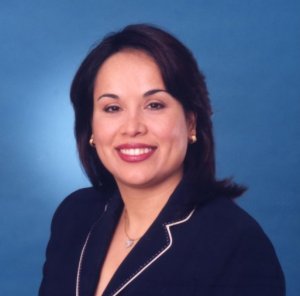
Idalia Fernandez, president, Hispanic College Fund
“A heavy investment has been made in these sites because the Hispanic College Fund recognizes the power of creating positive change at the grassroots level,” said Idalia Fernandez, president of the Hispanic College Fund. “With students getting much of their information from social networking sites like Facebook, we want these sites to be just as exciting while providing substantial information for all students, as well as the community at large. In fact, the websites include a link to a Hispanic Youth Symposium Facebook Cause, where students can obtain information about college and career opportunities posted by their peers.”
The Hispanic Youth Symposium Program is dedicated to creating a pool of Hispanic high school students focused on attending college and securing professional careers. Ideal participants are Hispanic high school students who live in one of the seven cities and surrounding counties where this year’s symposia will take place; have a GPA of 2.5 or higher; and will be a sophomore, junior, or senior next year.
During the initiative, 200 students travel to a local college campus for a three-night, four-day program. The short term goal is for students develop a network of like-minded peers, connect with role models and mentors, learn about resources that will earn them a seat in college, compete for scholarships, and develop long-term career vision.
Hispanic Marketing and Public Relations Understanding and Targeting America’s Largest Minority book

“A must resource for practitioners/professionals expecting to reach US Hispanics; also valuable for college programs in marketing, public relations and communications. Highly recommended.”
Choice magazine
Click here for information on the Hispanic Marketing & Public Relations books
More than 100 community volunteers assist with on-site coordination while businesses provide sponsorships, speakers, mentors, and recruiting opportunities. Representatives from various colleges present sessions on college preparation and admission. Following the symposium, participants may have access to additional information and resources to further their college bound goals. Funding is based on donations from individual donors and corporate sponsors, including companies such as Sallie Mae, Lockheed Martin, and Google.
“We still need funding for 400 of the 1,300 students attending symposia this summer. We are currently launching a Match Campaign in which an anonymous donor will match a percentage of the total amount we are able to raise in order to fund these 400 students,” said Sandoval.
Founded in 1993, the Hispanic College Fund is a non-profit organization based in Washington, D.C., with a mission is to develop the next generation of Hispanic professionals. The organization has provided scholarships internship and mentoring programs for students throughout the United States and Puerto Rico. The Hispanic College Fund has an annual budget of $6 million and 20 full-time employees.
“Beyond the 30 Second Spot” audio recording
Listen to a 105-minute discussion



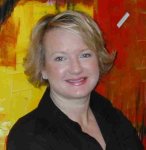
Panelists Ivan Cevallos, Hunter Heller, Kitty Kolding and Cynthia Nelson
Our panel of national experts discuss
• Challenges of measuring the impact of the 30-second ad spot
• Innovative tools are useful to reach Latinos
• Changes in marketing to Hispanics
• On which market segment are the changes most relevant
• Effects of technology and time shift on consumer behavior
• Role of multi-screens
• Getting started
• Tips for marketing professionals
Click here for information on Beyond the 30 Second Spot
Posted by Elena del Valle on June 11, 2008
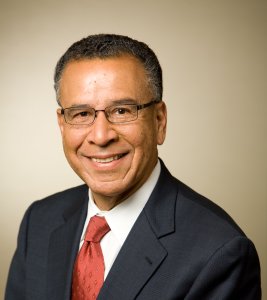
Jacob Lozada, board member, AARP
Photo: AARP
Some Hispanics feel the impact of recent economic hardships more harshly than other groups, according to a recent 32-page report prepared by Gerard Rainville and released by the American Association of Retired People (AARP). The findings are based on a national telephone survey, in English and Spanish, of 1,002 adults 45 years of age and older conducted by Woelfel Research, Inc. between April 12 and April 23, 2008. The individuals selected were part of a nationally representative sample that included 400 Hispanics. Researchers generalized their findings by including an oversample of Latino respondents.
The survey, The Economic Slowdown’s Impact on Middle-Aged and Older Hispanics, part of AARP’s examination of how Americans 45 and older are faring through economic difficulties, found that 86 percent of Hispanics 45 and older who were surveyed said the economy is in fairly bad or very bad condition, and 82 percent said it is getting worse.
“The current economic downturn is forcing many in the Hispanic community to take very difficult choices between their immediate needs and long-term financial security,” said Jacob Lozada, board member of AARP.
The AARP study led researchers to conclude that two-thirds of all Americans 45 and older are having a harder time paying for food, gas and medicine. At the same time, they concluded four in five Hispanic respondents (80 percent) are struggling to afford daily necessities.
“Segmentation by Level of Acculturation” audio recording

Presenter Miguel Gomez Winebrenner
Discusses
- Assimilation versus acculturation
- Factors that affect Latino acculturation
- How to know if someone is acculturated
- Number of years necessary for acculturation
- Effects of immigration debate on acculturation
- Three main ways of segmenting Latinos
Click here for details about “Segmentation by Level of Acculturation”
The researchers also believe middle aged and older Hispanics are more likely than the general population of people 45 and older to have difficulty paying their mortgage or rent (41 percent to 26 percent), and paying for educational expenses (32 percent to 19 percent). AARP representatives also believe Latinos are suffering more acutely as a result of the high foreclosure rates. Forty-one percent of respondents to the survey said they are feeling concerned about losing their home and 77 percent said they worry about the safety of neighborhoods with many foreclosed homes.
AARP representatives believe economic pressures are forcing middle-aged and older Hispanics to make difficult choices that could have dire long-term consequences. One third of the 400 individuals surveyed by phone said they had stopped depositing money into a 401(k), IRA or other retirement account, and more than 26 percent said they are prematurely raiding these savings accounts. Twenty–two percent of those surveyed said they are cutting back on medications and 31 percent said they have postponed paying some bills.
“We are going to feel the effects of this economic crisis for many years to come,” said Lozada. “Raiding your nest egg has a compounding effect because that money is not allowed to grow at a time when you have fewer working years to make up the losses.”
On the other hand, many of those surveyed said they are spending cautiously, spending less on entertainment and eating out (71 percent) while 62 percent are postponing travel plans and major purchases. About one quarter of respondents said they postponed retirement plans and 23 percent said they are working more hours.
Many of respondents, 44 percent, helped a child with bills or expenses and 18 percent helped their parents in the same way. Fourteen percent allowed one of their children to move in with them for financial reasons and 5 percent allowed their parents to do the same. Ten percent of participants in the survey sought help from family, churches or charities.
AARP is a nonprofit, nonpartisan membership organization of 39 million people aged 50 and older. Two of AARP’s board members are Hispanic. According to the AARP website, in April 2007 1.2 million of the organization’s members were Hispanic.
Target Latinos effectively by anticipating changes in the market with
“Hispanic Projections with 2007-08 update” audio recording

Presenter Roger Selbert, Ph.D.
Find out
- About Latino buying power growth in the future
- How Latino market growth compares with other markets in the U.S.
- What drives the rise of Latino economic clout
- Who should target the Latino market
- What is the size of the Hispanic affluent market
- If the luxury Latino market is growing
Stay ahead of your competition with “Hispanic Projections”
Posted by Elena del Valle on June 10, 2008
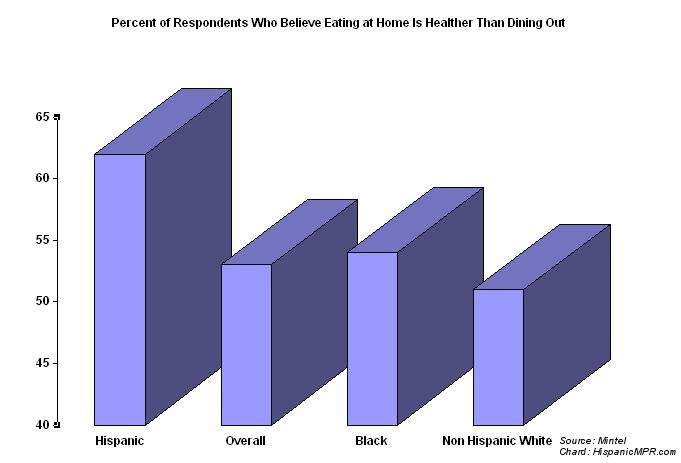
Dining out preferences by ethnic group – click on image to enlarge
Photos: Mintel, Pizza Patron
According to a recent study, people are dining out less often because of economic hardships. At the same time, the study indicates growth in restaurants in the coming years will be the result of patronage from Echo Boomers (children of Baby Boomers) and Hispanic and Asian immigrants.
Studies indicate ethnic restaurant goers are more likely to seek exotic flavors. This is significant because some researchers believe the Echo Boom generation, many of which are immigrants or children of immigrants, will show the greatest increase in percentage of the overall population between 2002 and 2012.
A November 2007 study by the National Restaurant Association, indicates restaurant activity has fallen to its lowest level since February 2003 because customers are dining out less frequently. It is also noteworthy that 51 percent of restaurants surveyed expect economic conditions to worsen in the coming months. Mintel research from January 2008 indicates that 54 percent of people who dine out regularly are cutting back on restaurant spending because of the economy.
“Best in Class Hispanic Strategies” audio recording


Presenters Carlos Santiago and Derene Allen
-
Find out what makes 25 percent of the top 500 Hispanic market advertisers out perform the remaining companies
-
Discover what questions to ask, steps to take to be a Best in Class company
Click here for more about “Best in Class Hispanic Strategies” audio recording
Many Americans are eating out less often blaming their decision on the skyrocketing price of fuel and increases in many consumer goods including food, as well as the boom in home foreclosures and the recession. Seventy percent of consumers who responded to the Mintel survey are attempting to save on meals by going out to eat fewer times a month instead of choosing cheaper entrees or dining at less expensive restaurants.

David Morris, senior analyst, Mintel
“People aren’t trading down for cheaper or lower quality food; they’re just trading out,” said David Morris, senior analyst at Mintel. “Especially when you consider the price of casual and fine dining, staying in can reduce costs significantly.”
Hispanics many not be surprised to discover that few Latino oriented selections were found among the national trends identified by Mintel researchers. The company’s executive summary indicates that “Although efforts to target the Hispanic community are notable, there is a lack of Hispanic taste-inspired menu items that would likely be a popular addition.”
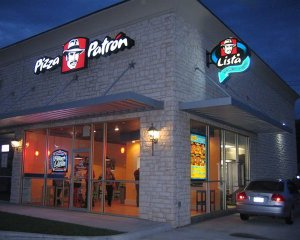
A Pizza Patron restaurant
In general, adults 18 to 24 years old are the group most likely to say that they are spending more. Older adults, aged 45 to 54 are those most likely to cut back on spending. Hispanics respondents were the most likely to believe at home meals are healthiest. Sixty-two percent of Latino respondents believed “I could eat healthier if I ate at home instead of going to a restaurant;” compared to consumers overall (53 percent), white (51 percent) and black (54 percent) respondents.
The Mintel survey was weighted against the U.S. population to make it representative of the varied demographic groups For the purposes of this report, Mintel commissioned exclusive consumer research through Greenfield Online to explore consumer attitudes towards dining out. Researchers conducted fieldwork in January 2008 among a nationally representative sample of 2,000 adults aged 18 and older.
Mintel also analyzed data from Simmons Research, using the National Consumer Survey (NCS) which was conducted between May 2006 and June 2007. The results presented in the Mintel study are based on a sample of 25,375 adults 18 and older with results weighted to represent the U.S. population.
Founded in 1919, the National Restaurant Association is a restaurant industry business association. Mintel, founded in the United Kingdom 35 years ago, is a supplier of consumer, media and market research. The company, with offices in Chicago, London, Belfast, Sydney and Shanghai, has been studying the United States Hispanic market since 2003.
Hispanic Marketing and Public Relations Understanding and Targeting America’s Largest Minority book

“A must resource for practitioners/professionals expecting to reach US Hispanics; also valuable for college programs in marketing, public relations and communications. Highly recommended.”
Choice magazine
Click here for information on the Hispanic Marketing & Public Relations books










































